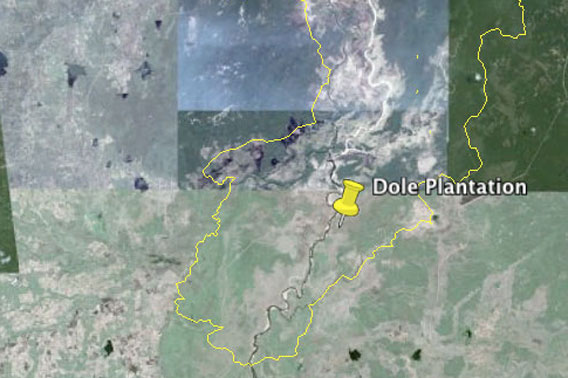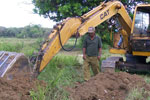
Dole plantation’s location within Somawathiya National Park as given by source on Google Earth. Click to enlarge image to see full park size including plantation.
Environmental NGOs in Sri Lanka have accused US food giant Dole of illegally growing bananas in Somawathiya National Park, however Dole has denied the charge saying the land in question is ‘not in the [park]’. Mongabay.com has received the coordinates of the Dole plantation from an anonymous source in Sri Lanka familiar with the issue, and using Google Earth has found that the plantation in question is clearly inside park boundaries.
Partnering with a local company, Letsgrow Ltd, Dole recently released a statement addressing the issue.
“Dole Lanka [Sri Lanka’s branch of Dole] cultivates a farm in Kandakaduwa for Letsgrow (Private) Limited who has confirmed to Dole Lanka that the farm is not in the Somawathiya National Park. Dole is in the process of obtaining confirmation on the exact location of the park vis-à-vis its farm.”
However, using Google Earth, the coordinates of the plantation, and the boundaries of the park as found on protectedplanet.net, mongabay.com was able to verify that the coordinates of the plantation are well inside the park’s boundaries. One cannot see the plantation itself on Google Earth, since the satellite images are too old. But, the anonymous source said that Dole has been confronted with satellite imagery from this year obtained by the NGO, Environmental Foundation Limited (EFL). The source also told mongabay.com that Dole will likely try to pin the blame for the illegal clearing of protected lands on its company partner, Letsgrow Ltd.
“Dole should be accountable for the partners they pick. None of their other plantations have obtained environment clearances, environmental impact assessments etc. as required by law. Working in countries where rules are bent [means] they should do the due diligence themselves instead of relying on the word of local partners,” the source said.
The issue also raises questions about Dole’s continued insistence that they were not clearing park land when given open access to satellite imagery, one can easily verify such questions remotely.
The source added that photos show the plantation goes all the way up to the banks of the Mahaweli River, another breach of Sri Lankan law. River vegetation is especially important for biodiversity, including a species of special concern: elephants.
Between 400 and 500 Sri Lankan elephants (Elephas maximus maximus), a subspecies of the Asian elephant, are believed to inhabit the park. The subspecies is listed as Endangered by the IUCN Red List due to large-scale habitat loss. Environmentalists fear that Dole’s plantation could harm the elephant population, but in its statement Dole denied any impacts on elephants.
“While elephants are common animals in Sri Lanka, they are not very common in this farm area. However, our workers do receive training on ‘elephant attack awareness’ to protect both the elephants and our workers. There is no electric fence around this farm preventing elephants from entering since the probability is limited,” Dole said.
But a conservationist working in Sri Lanka, who also wished to remain anonymous, recently told mongabay.com: “In the short term, as banana cultivation is underway and elephants are still in the area, elephants will likely visit the plantations in search of food and risk being killed. If they are eventually excluded from the area, they will be driven to areas that are already inhabited by people. This will result in increased human-elephant conflict and will be detrimental to both human and elephant populations. Ultimately, the number of elephants left will depend on the amount of forest left. If there is no forest left, there will be no elephants.”
Other threatened species that could be impacted by the destruction in the area include the rusty spotted cat (Prionailurus rubiginosus), which is listed as Vulnerable by the Red List; the fishing cat (Prionailurus viverrinus) and the Sri Lankan leopard, both Endangered; and the painted stork (Mycteria leucocephala), classified as Near Threatened. The park is also home to water buffalo, crested hawk eagles, and sambars, among a wide-variety of other species.
No Environmental Impact Assessment was ever produced for the plantation and the company has barred officials from visiting the site.
Related articles
Dole responds to allegations it is illegally growing bananas in national park
(10/02/2011) Dole Food Company has responded to allegations that it is clearing land in a national park in Sri Lanka known for its population of elephants as well as a number of threatened species. According to reports, the US-based food giant has partnered with a local company, Letsgrow Ltd, to grow bananas for export markets in Somawathiya National Park.
Dole destroying forest in national park for bananas

(08/14/2011) Dole Food Company, a US-based corporation famous for its tropical fruit products, is allegedly destroying rainforest in Somawathiya National Park in Sri Lanka for a banana plantation reports local press. The 4,700 hectare (11,600 acre) plantation, reportedly handed to local company Letsgrow by Sri Lanka’s military, imperils an elephant migration route and a number of tropical species. Letsgrow has partnered with Dole on the plantation work, already clearing almost half the area, described as ‘thick jungle’. Sri Lanka, which has only come out of a decades-long civil war in 2009, is currently seeking a rise in agricultural development.
Sri Lanka’s rainforests fast-disappearing but hope remains

(11/07/2006) Sri Lanka, an island off the southern-most point of India, is known as a global biodiversity hotspot for its high number of species in a relatively limited area. However this biological richness is highly threatened by one of the highest deforestation rates of primary forests in the world. In that period, the country lost more than 35 percent of its old-growth forest cover, while total forest cover was diminished by almost 18 percent. Worse, since the close of the 1990s, deforestation rates have increased by more than 25 percent. Dr Ranil Senanayake, chairman of Rainforest Rescue International, a grassroots environmental organization based in Sri Lanka, says that the key to saving the island’s last forests is to “reintroduce the concept of sustainable livelihood” to the people living in and around the island’s rainforests by establishing “commercially viable projects that explore the social and cultural relationships between people and ecology.”







